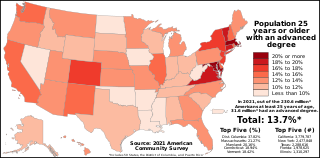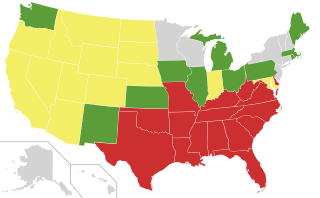Related Research Articles
Cohabitation is an arrangement where people who are not married, usually couples, live together. They are often involved in a romantic or sexually intimate relationship on a long-term or permanent basis. Such arrangements have become increasingly common in Western countries since the late 20th century, being led by changing social views, especially regarding marriage, gender roles and religion.
Divorce is the process of terminating a marriage or marital union. Divorce usually entails the canceling or reorganizing of the legal duties and responsibilities of marriage, thus dissolving the bonds of matrimony between a married couple under the rule of law of the particular country or state. Divorce laws vary considerably around the world, but in most countries, divorce requires the sanction of a court or other authority in a legal process, which may involve issues of distribution of property, child custody, alimony, child visitation / access, parenting time, child support, and division of debt. In most countries, monogamy is required by law, so divorce allows each former partner to marry another person.
In family law, effects of marriage is a legal term of art used to describe all of the rights and obligations that individuals may be subject and entitled to if they are in a common-law marriage, an annulled marriage, domestic partnership or a civil union.

Premarital sex is sexual activity which is practiced by people before they are married. Premarital sex is considered a sin by a number of religions and also considered a moral issue which is taboo in many cultures. Since the Sexual Revolution of the 1960s, it has become accepted by certain liberal movements, especially in Western countries. A 2014 Pew study on global morality found that premarital sex was considered particularly unacceptable in "Muslim Majority Countries", such as Malaysia, Jordan, Pakistan, and Egypt, each having over 90% disapproval, while people in Western European countries were the most accepting, with Spain, Germany, and France expressing less than 10% disapproval.

The working poor are working people whose incomes fall below a given poverty line due to low-income jobs and low familial household income. These are people who spend at least 27 weeks in a year working or looking for employment, but remain under the poverty threshold.

Sociology of the family is a subfield of the subject of sociology, in which researchers and academics study family structure as a social institution and unit of socialization from various sociological perspectives. It can be seen as an example of patterned social relations and group dynamics.

The educational attainment of the U.S. population refers to the highest level of education completed. The educational attainment of the U.S. population is similar to that of many other industrialized countries with the vast majority of the population having completed secondary education and a rising number of college graduates that outnumber high school dropouts. As a whole, the population of the United States is spending more years in formal educational programs. As with income, levels differ by race, age, household configuration, and geography.
The terms average Joe, ordinary Joe, Joe Sixpack, Joe Lunchbucket, Joe Snuffy, Joe Blow, Joe Schmoe and ordinary Jane, average Jane, and plain Jane, are used primarily in North America to refer to a completely average person, typically an average American. It can be used both to give the image of a hypothetical "completely average person" or to describe an existing person. Parallel terms in other languages for local equivalents exist worldwide.
Remarriage is a marriage that takes place after a previous marital union has ended, as through divorce or widowhood. Some individuals are more likely to remarry than others; the likelihood can differ based on previous relationship status, level of interest in establishing a new romantic relationship, gender, culture, and age among other factors. Those who choose not to remarry may prefer alternative arrangements like cohabitation or living apart together. Remarriage also provides mental and physical health benefits. However, although remarried individuals tend to have better health than individuals who do not repartner, they still generally have worse health than individuals who have remained continuously married. Remarriage is addressed differently in various religions and denominations of those religions. Someone who repeatedly remarries is referred to as a serial wedder.

The lives, roles, and rights of women in Chile have gone through many changes over time. Chilean women's societal roles have historically been impacted by traditional gender roles and a patriarchal culture, but throughout the twentieth century, women increasingly involved themselves in politics and protest, resulting in provisions to the constitution to uphold equality between men and women and prohibit sex discrimination.

The society of the United States is based on Western culture, and has been developing since long before the United States became a country with its own unique social and cultural characteristics such as dialect, music, arts, social habits, cuisine, and folklore. Today, the United States of America is an ethnically and racially diverse country as a result of large-scale immigration from many different countries throughout its history.
Cohabitation in the United States is loosely defined as two or more people, in an intimate relationship, who live together and share a common domestic life but are neither joined by marriage nor a civil union.

Interracial marriage has been legal throughout the United States since at least the 1967 U.S. Supreme Court decision Loving v. Virginia (1967) that held that anti-miscegenation laws were unconstitutional via the 14th Amendment adopted in 1868. Chief Justice Earl Warren wrote in the court opinion that "the freedom to marry, or not marry, a person of another race resides with the individual, and cannot be infringed by the State." Since Loving, several states repealed their defunct bans, the last of which was Alabama in a 2000 referendum. Interracial marriages have been formally protected by federal statute through the Respect for Marriage Act since 2022.

Women in Madagascar, also known as Malagasy women or Malgache women, generally live longer than men, whom they outnumber. Marrying young, they are traditionally subservient to their husbands. Roughly a third have their first child before the age of 19, and those who wish to delay having children may not have access to contraceptives. Abortion is common, with an estimated 24 percent of women having had one. Although they are constitutionally equal to men, they have unequal property rights and employment opportunities in certain areas.
Work–family balance in the United States refers to the specific issues that arise when men and women in the United States attempt to balance their occupational lives with their family lives. This differs from work–life balance in the United States: while work–life balance may refer to the health and living issues that arise from work, work–family balance refers specifically to how work and families intersect and influence each other. Work–family balance in the U.S. differs significantly for families of different social class.
The term juvenilization of poverty is one used to describe the processes by which children are at a higher risk for being poor, suffer consistent and long-term negative effects due to deprivation, and are disproportionately affected by systemic issues that perpetuate poverty. The term connotes not just the mere existence of child poverty but the increase in both relative and absolute measures of poverty among children as compared to both other vulnerable groups and the population at large.

Socioeconomic mobility in the United States refers to the upward or downward movement of Americans from one social class or economic level to another, through job changes, inheritance, marriage, connections, tax changes, innovation, illegal activities, hard work, lobbying, luck, health changes or other factors.

The family structure of African Americans has long been a matter of national public policy interest. A 1965 report by Daniel Patrick Moynihan, known as The Moynihan Report, examined the link between black poverty and family structure. It hypothesized that the destruction of the black nuclear family structure would hinder further progress toward economic and political equality.
Cohabitation in the United Kingdom, according to social security law would typically relate to a couple being treated as living together as a married couple even if not married or in a civil partnership. This has the effect that for means-tested benefits their resources are treated as held in common. There are also effects on benefits which depend on the claimant not having a partner.
Bangladesh did not exist as a distinct geographic and ethnic unity until independence. The region had been a part of Bangla, Bengali: বাংলা/বঙ্গ, whose history dates back to four millennia, and during the British period it formed the Bengal province, the eastern part of the British Indian Empire, which was dominated by the British rulers and Hindu professional, commercial, and landed elites. After the establishment of Pakistan in 1947, present-day Bangladesh came under the hegemony of the non-Bengali Muslim elites of the West Wing of Pakistan. The establishment of Bangladesh, therefore, implied the formation of both a new nation and a new social order.
References
This article includes a list of general references, but it lacks sufficient corresponding inline citations .(November 2015) |
- Antonovics, Kate; Robert Town (2003-11-01). "Are All The Good Men Married? Uncovering the Sources of the Marital Wage Premium" (PDF). Department of Economics, UCSD. 2003 (15). Retrieved 2007-05-30. Cited in Varian.
- Breusch, Trevor; Edith Gray (2004-09-17). "Does marriage improve the wages of men and women in Australia?" (PDF). 12th Biennial Conference. Australian Population Association. Archived from the original (PDF) on 2006-11-04. Retrieved 2007-04-27.
- Cauchon, Dennis (2006-09-27). "Marriage gap could sway elections". USA TODAY. Retrieved 2007-04-27.
- Ellwood, David T.; Christopher Jencks (October 2002). "The Spread of Single-Parent Families in the United States since 1960" (PDF). Harvard University. Retrieved 2007-04-27.
- Hymowitz, Kay S. (December 2006). "Marriage and Caste". City Journal. Retrieved 2007-04-27.
- Jacoby, Jeff (2006-03-12). "The politics of female voters". Boston.com. The Boston Globe. Retrieved 2007-05-01.
- "Marriage Gap Bigger than Gender Gap" (Press release). National Annenberg Election Survey, NAES. 2004-07-02. Retrieved 2007-05-30.
- Varian, Hal R. (2004-07-29). "Analyzing the Marriage Gap". The New York Times. Retrieved 2007-04-27.
- Wilson, J. Matthew; Michael Lusztig (December 2004). "The Spouse in the House: What Explains the Marriage Gap in Canada?" (PDF). Southern Methodist University. Retrieved 2007-05-01.